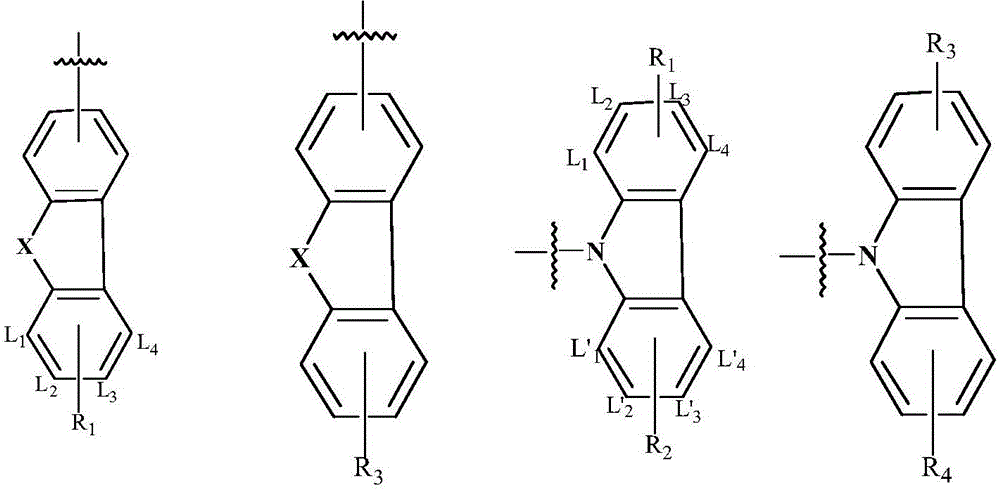Organic aromatic compound and application of organic aromatic compound in organic electroluminescent device
An aromatic compound and compound technology, applied in organic chemistry, electrical solid devices, electrical components, etc., can solve the problems of low S1 state radiation transition rate, difficult exciton utilization rate, high fluorescence radiation efficiency, and efficiency roll-off, etc. Good prospects for industrialization, avoiding agglomeration, increasing the effect of track overlap
- Summary
- Abstract
- Description
- Claims
- Application Information
AI Technical Summary
Problems solved by technology
Method used
Image
Examples
Embodiment 1
[0048] Embodiment 1: the synthesis of compound 01
[0049]
[0050] The concrete synthetic route of this compound is provided now:
[0051]
[0052] In a 250ml four-necked flask, under a nitrogen atmosphere, add 0.012mol of intermediate A, 0.01mol of acridine spiroanthrone, 0.03mol of sodium tert-butoxide, 1×10 -4 mol Pd 2 (dba) 3 , 1×10 -4 mol of tri-tert-butylphosphine, 250ml of toluene, heated to reflux for 16 hours, sampling plate, reaction complete, natural cooling, filtration, filtrate rotary evaporation, silica gel column to obtain the target product with a purity of 98.7% and a yield of 62.8.00%.
[0053] Elemental analysis structure (molecular formula C 50 h 23 N 2 o 2 ): theoretical value C, 86.68; H, 4.66; N, 4.04; O, 4.62; test value: C, 86.80; H, 4.57; N, 3.92;
[0054] HPLC-MS: The molecular weight of the material is 692.8, and the measured molecular weight is 692.3.
Embodiment 2
[0055] Embodiment 2: the synthesis of compound 04
[0056]
[0057] The concrete synthetic route of this compound is provided now:
[0058]
[0059] In a 250ml four-neck flask, under an atmosphere of nitrogen gas, add 0.012mol of intermediate B, 0.01mol of acridine spiroanthrone, 0.03mol of sodium tert-butoxide, 1×10 -4 mol Pd 2 (dba) 3 , 1×10 -4 mol of tri-tert-butylphosphine, 200ml of toluene, heating and reflux for 20 hours, sampling point plate, reaction complete, natural cooling, filtration, filtrate rotary evaporation, silica gel column to obtain the target product with a purity of 98.2% and a yield of 70.05%.
[0060] Elemental analysis structure (molecular formula C 56 h 37 N 3 O): theoretical value C, 87.59; H, 4.86; N, 5.47; O, 2.08; tested value: C, 87.45; H, 4.66; N, 5.31;
[0061] HPLC-MS: The molecular weight of the material is 767.91, and the measured molecular weight is 761.54.
Embodiment 3
[0062] Embodiment 3: the synthesis of compound 05
[0063]
[0064] The concrete synthetic route of this compound is provided now:
[0065]
[0066] In a 250ml four-neck flask, under an atmosphere of nitrogen gas, add 0.012mol of intermediate C, 0.01mol of acridine spiroanthrone, 0.03mol of sodium tert-butoxide, 1×10 -4 mol Pd 2 (dba) 3 , 1×10 -4 mol tri-tert-butylphosphine, 250ml toluene, heated to reflux for 20 hours, sampled and spotted, reacted completely, naturally cooled, filtered, filtrate rotary evaporated, passed through a silica gel column to obtain the target product with a purity of 97.8% and a yield of 68.2%.
[0067] Elemental analysis structure (molecular formula C 56 h 37 N 3 O): Theoretical value C, 87.59; H, 4.86; N, 5.47; O, 2.08; Test value: C, 87.42;
[0068] HPLC-MS: The molecular weight of the material is 767.91, and the measured molecular weight is 761.61.
PUM
| Property | Measurement | Unit |
|---|---|---|
| thickness | aaaaa | aaaaa |
Abstract
Description
Claims
Application Information
 Login to View More
Login to View More - R&D
- Intellectual Property
- Life Sciences
- Materials
- Tech Scout
- Unparalleled Data Quality
- Higher Quality Content
- 60% Fewer Hallucinations
Browse by: Latest US Patents, China's latest patents, Technical Efficacy Thesaurus, Application Domain, Technology Topic, Popular Technical Reports.
© 2025 PatSnap. All rights reserved.Legal|Privacy policy|Modern Slavery Act Transparency Statement|Sitemap|About US| Contact US: help@patsnap.com



